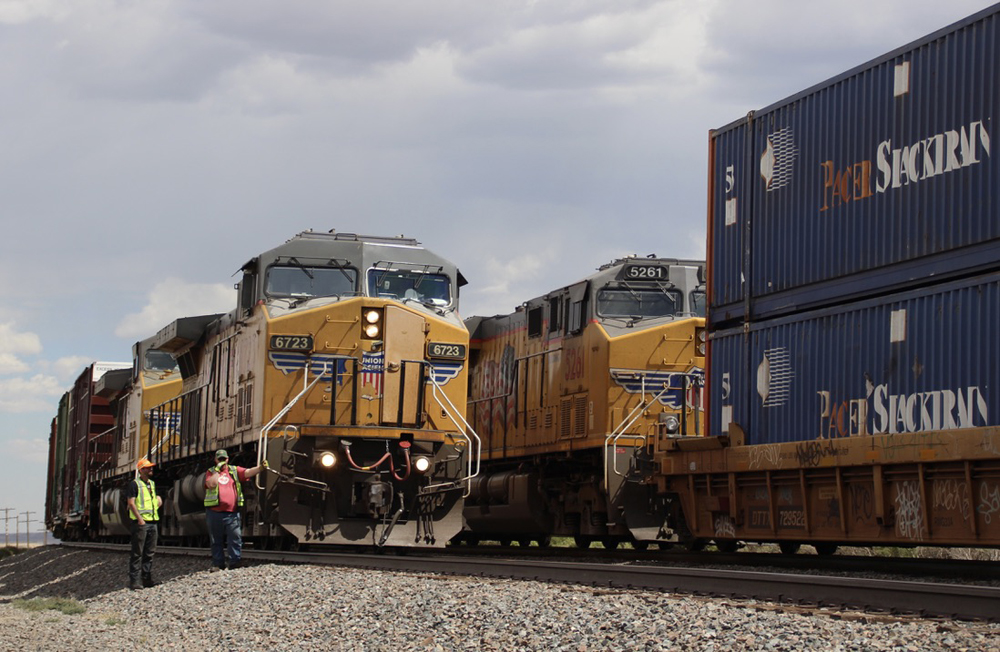
CHICAGO – Union Pacific is running a small pilot program in Kansas that aims to bring more predictability to engineer schedules.
The experiment comes as railroads have been having trouble retaining train crews and hiring new conductors at many locations across their systems — due in part to the unpredictable nature of the jobs.
Ongoing crew shortages at UP, BNSF Railway, CSX Transportation, and Norfolk Southern have created widespread service problems that have drawn the ire of shippers and the attention of regulators.
Eric Gehringer, UP’s executive vice president of operations, says about 40% of the railroad’s train crews — primarily those working in yard and local service — have scheduled jobs.

The remaining 60% of UP’s train and engine jobs are unscheduled. To provide more predictability in road freight service, UP is working with the Brotherhood of Locomotive Engineers and Trainmen on the pilot program that lets engineers know when they’ll work every 15 days.
Under the “11 and four” schedule, engineers know which 11 days they’ll work and which four days they’ll be off during every 15-day period, Gehringer told an investor conference on Tuesday.
“It’s something we have to do through the collective bargaining agreement. We can’t just instantly put that across the system,” Gehringer says, adding that he’s excited to see what the results will be over the 60 days left in the pilot program.
The goal, he says, will be to see how UP could expand the work-rest scheduling system.
“Union Pacific understands how important it is to address quality-of-life concerns raised by our TE&Y employees. We started a pilot project Nov. 1 to test a work-rest cycle that includes scheduled days off for employees in jobs that have been traditionally unassigned,” railroad spokeswoman Robynn Tysver says. “We are working closely with union leaders on this project, which is in its infancy, and hope to gather a better understanding of how to best implement a work-rest balance more broadly throughout our system, while acknowledging there may not be a one-size-fits-all approach.”
Through national collective bargaining, labor leaders sought to improve working conditions after the implementation of Precision Scheduled Railroading and its related layoffs resulted in remaining employees working longer hours, being required to be available to work more often, and having difficulty scheduling time off.
The Presidential Emergency Board, convened last summer after unions and the railroads failed to reach a contract deal, recommended that these issues be negotiated locally.
Representatives from the BLET and the SMART-TD union, which represents conductors, did not immediately respond to Trains News Wire requests for comment today.
UP is nearing its goal of hiring 1,400 train and engine employees this year, Gehringer says, with two-thirds of the new hires in active service and one-third in training.
But the railroad remains short of crews across its northern tier and is offering hiring bonuses of $10,000 to $25,000 to new conductors at some locations, including Cheyenne and Green River, Wyo.; Salt Lake City and Helper, Utah; Portland, Ore.; and Seattle.
“We still have those pockets where we are constrained,” Gehringer says. UP aims to hire about 500 additional conductor trainees this year.
Getting back to full strength on train crew staffing levels will improve service and help UP be more resilient when extreme weather or other events hit the railroad, UP executives say.
If the economy softens and freight demand drops, UP will use furloughs as a last resort so that it has enough crews to handle a rebound, Gehringer says. “That’s not a tool that we employ without thinking very carefully through that, because what we want to be most prepared for is when the demand shifts. We want to be able to capture that without missing a beat,” Gehringer says.

UP may be able to offset a freight downturn next year thanks to strong bulk traffic demand and new business wins, including the Schneider National and Knight-Swift intermodal contracts from BNSF as well as new renewable energy and steel traffic, says Jennifer Hamann, the railroad’s chief financial officer.
Gehringer and Hamann spoke at the Baird 2022 Global Industrial Conference.














Well if UP truly has taken away Schneider National and Swift/Knight from BNSF, then I think the need to schedule should be greatly enhanced by the additional volume. Of course if UP drags its feet on getting the new hires on the road, then they will not have learned a dam thing…
Is this a “dangling carrot” to prevent a strike? Only UP knows.
These RRs think they are so cutting edge & smart… ….but can’t project how many crews they’ll need in any given 8 or 12 hour window on any given day -despite all the volumes of data they generate showing this exact thing.
11/4 beats 24/7 on call, sure, but still lacks desired predictability.
You’d think for what management gets paid they could figure this out, or hire some 19 year old computer wizzes to do it for them.
Well, if the railroads actually p SCHEDULED r they wouldn’t have this problem. For something like unit trains and intermodal, running trains on a schedule should be rather simple, the trip plan for each car should be indentical. Further more, extrapolating on this, if you have scheduled trains that have counterparts both EB and WB, then you arrange the schedules so that under normal circumstances the trains meet half way through their journeys, the crews swap trains and return hom to their crew base. However, the actual method of developing a SCHEDULE for each individual carload doesn’t allow this approach at all. Also, not matching WB/EB volume because you want to run the longest trains possible(only feasible in one direction actually because of how the U.S. is designed as a consumer based economy and also population centers.
It’s not “P”recision, it’s not “S”cheduled, but it is “R”ailroading. So the corporations are batting .333. Which is Hall of Fame in baseball but not so much in transportation.
Judging by the union meeting I went to the other evening, this article is a pretty broad brush painting of the agreement. Missing some details.
I’m with you Charles, nothing like a little a$$ kissing in the wake of a looming mess they (the class ones) have invariably created. I’ve worked rest cycle boards on the railroad I work on and they were the best jobs an on call trainman or engineman could have.Unfortunately even though the railroad I work for that had them abolished them as being to expensive even though they had complete predictability for both sides. They had their crew base and we had out time off but alas it didn’t work for their pocket books……..Funny thing they had a minimal extra board that they had to pay and once they abolished the rest cycles they had to increase the extra boards ten fold negating any savings they could have possibly had. Another repercussion of their near sightedness was they went back to a crew base that to this day is still a mess and it’s been 14 years since they got rid of it. It was a 7/3 rest cycle meaning seven days on 3 days off. I forgot to mention that, none the less it was great and crews were happy but god forbid the company have contentment so it went the way of the dodo bird.
The problem is not which days I will work, but whether I will work consistent times during those days!? Absolutely not! There is no magic bullet for quality of life than consistent calling times on the days which I am available. But freight cannot run that way anymore. Ever. We signed on for a miserable way of life and the compensation is set to address that. Pay me extremely well and you can work me in ways science now knows will shorten my life but as I say PAY ME!
Nothing works as well as a looming work stoppage to focus the mind. About time the unions and management sit down and GET THIS DONE!!!!!!!! We wish them luck. May it succeed and may it spread to the other railroads and to all the states.